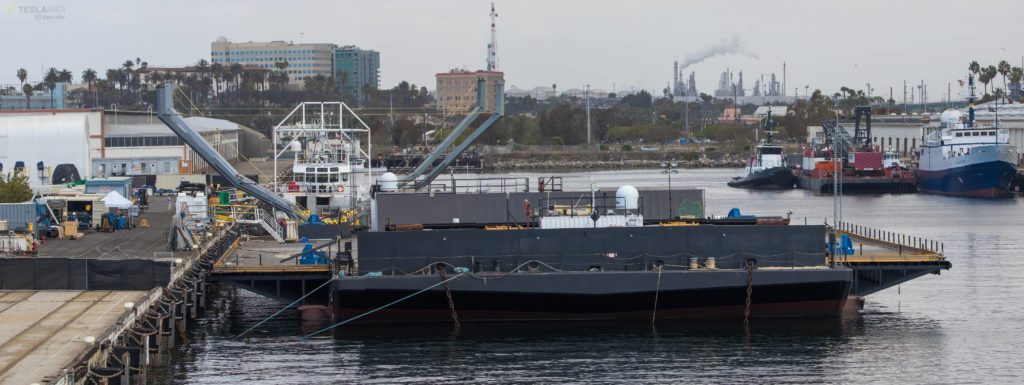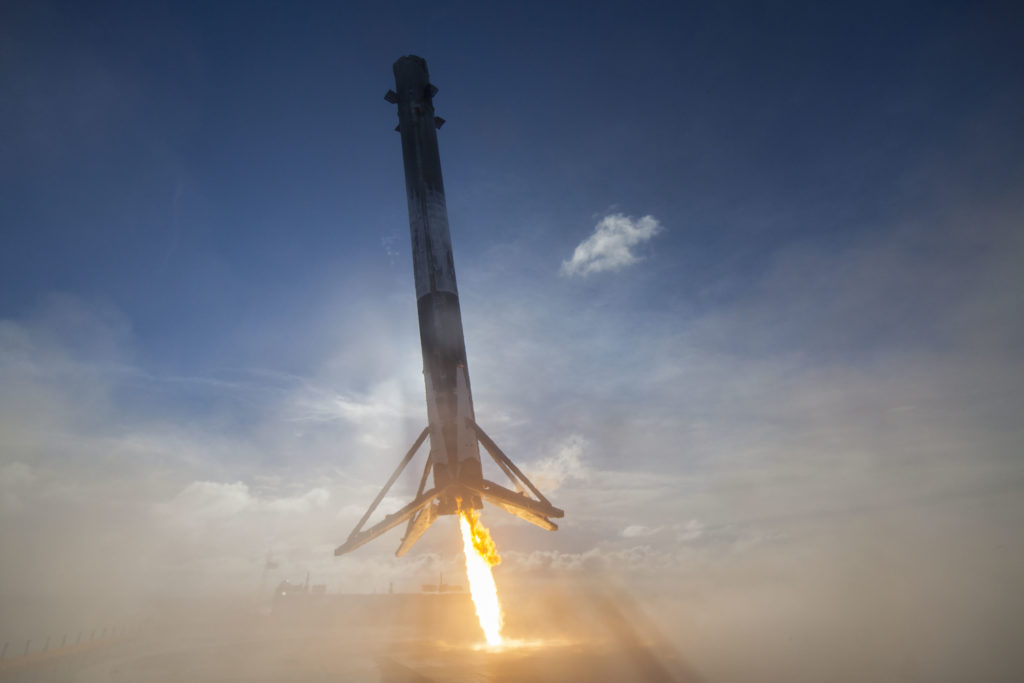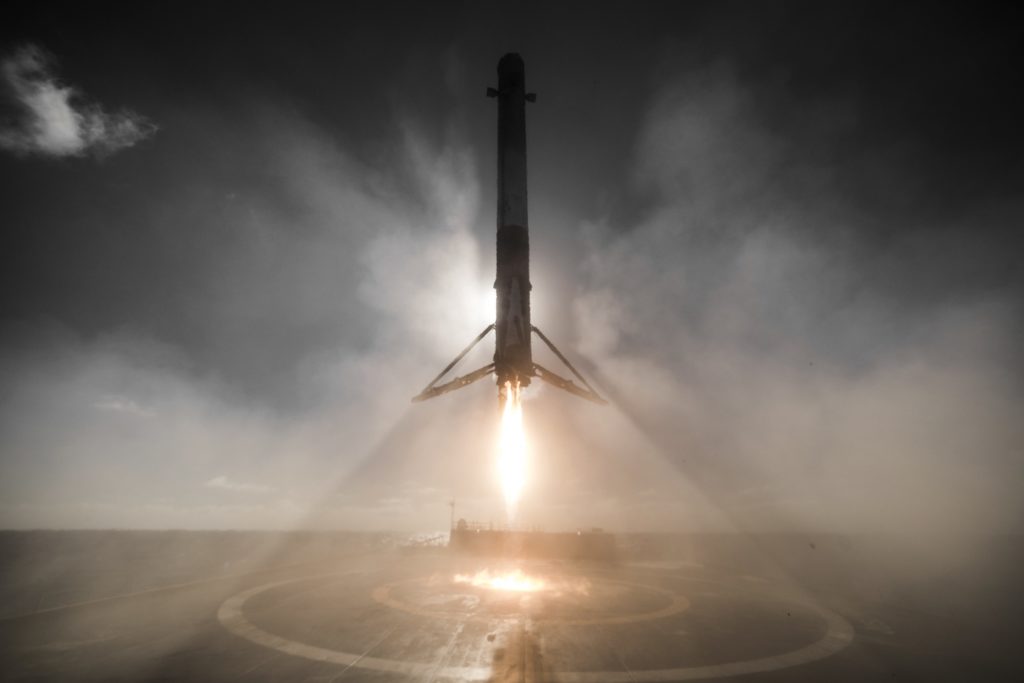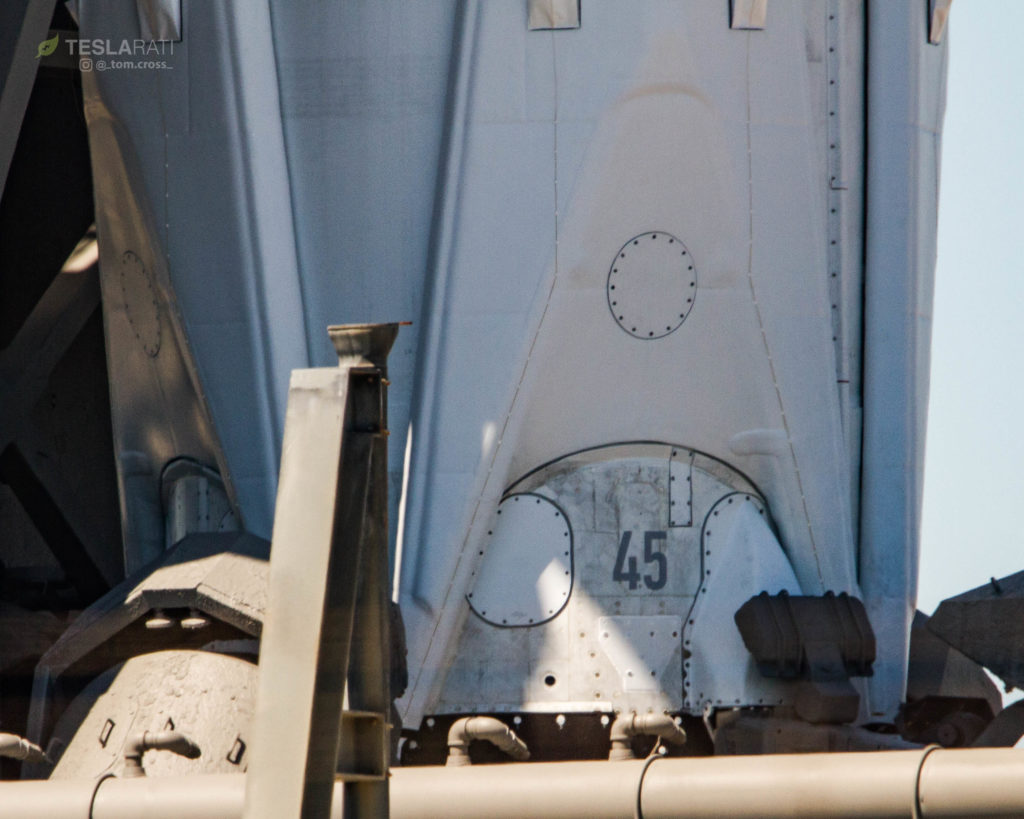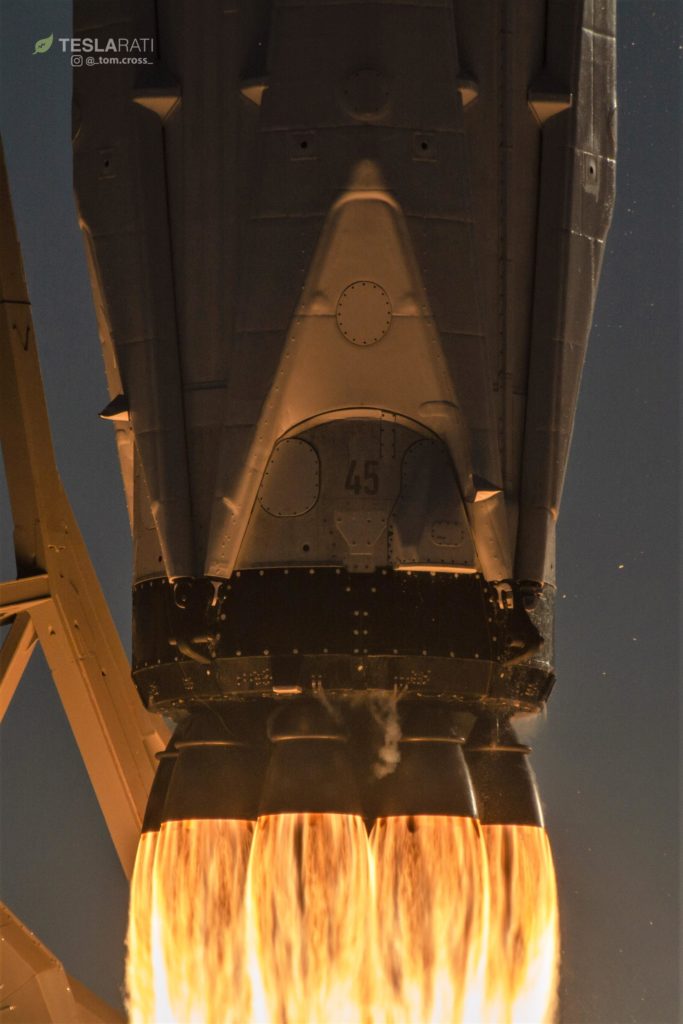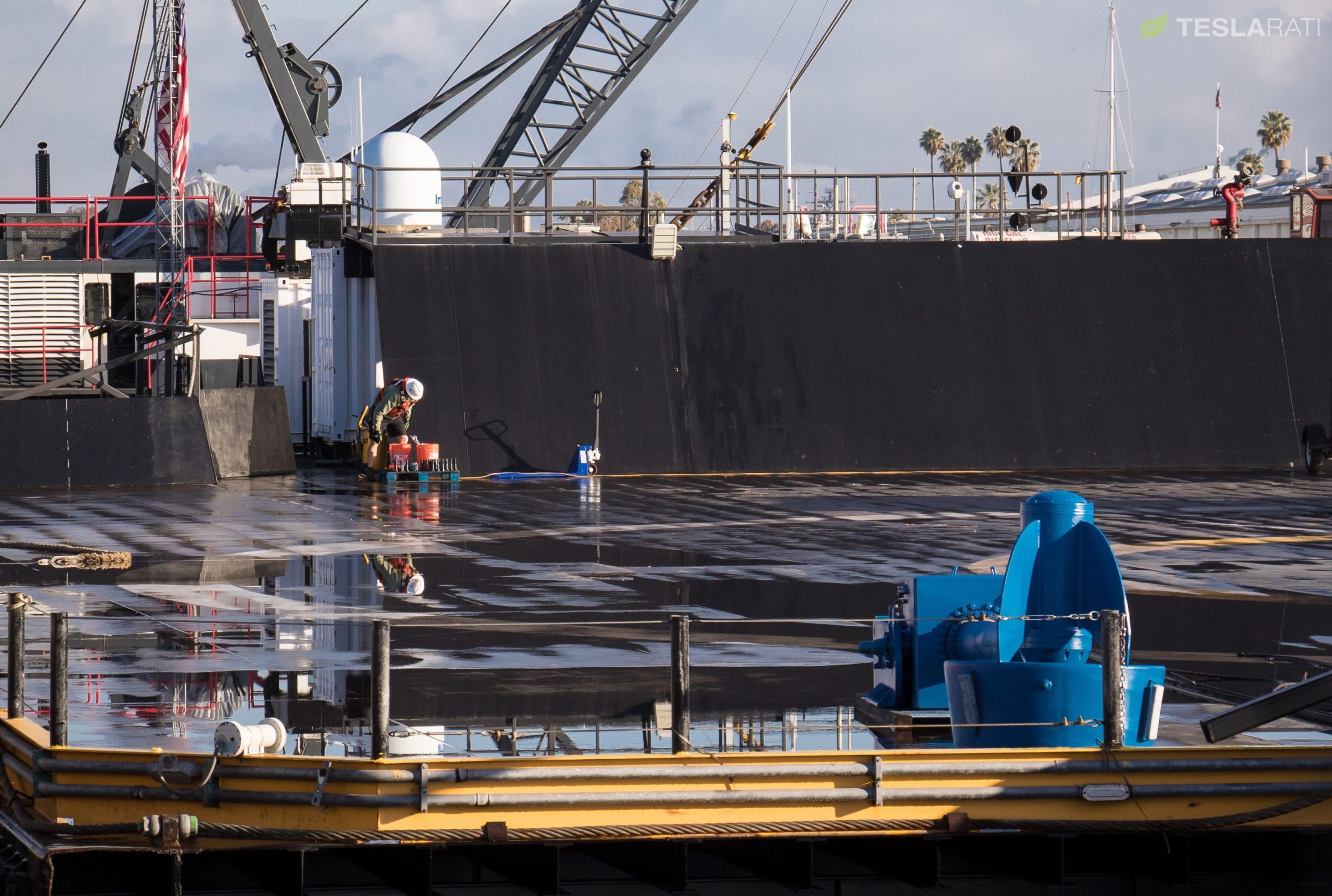
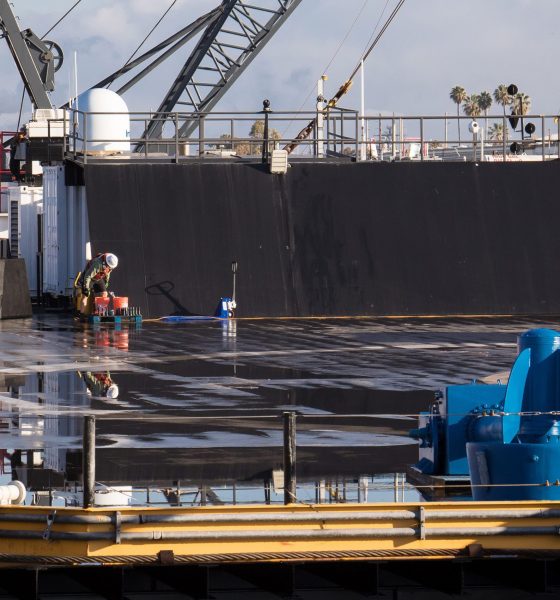
News
SpaceX’s drone ships near return-to-action with Block 5 Falcon 9 landings
Teslarati photographer Pauline Acalin’s recent trips to drone ship Just Read The Instructions’ berth in Port of San Pedro shows that SpaceX technicians are nearly done preparing the hibernating vessel for a return to Falcon 9 rocket recoveries in the Pacific Ocean, a ten-month drought likely to end for good on July 20th.
Although it’s hard to believe, SpaceX’s West Coast autonomous spaceport drone ship (ASDS) has been effectively marooned at its Port of Los Angeles berth for more than nine full months, with the vessel’s last recovery occurring just after the October 9 launch of ten Iridium NEXT satellites, the fourth of five SpaceX Vandenberg launches in 2017 (and the fourth of four West Coast booster landings).
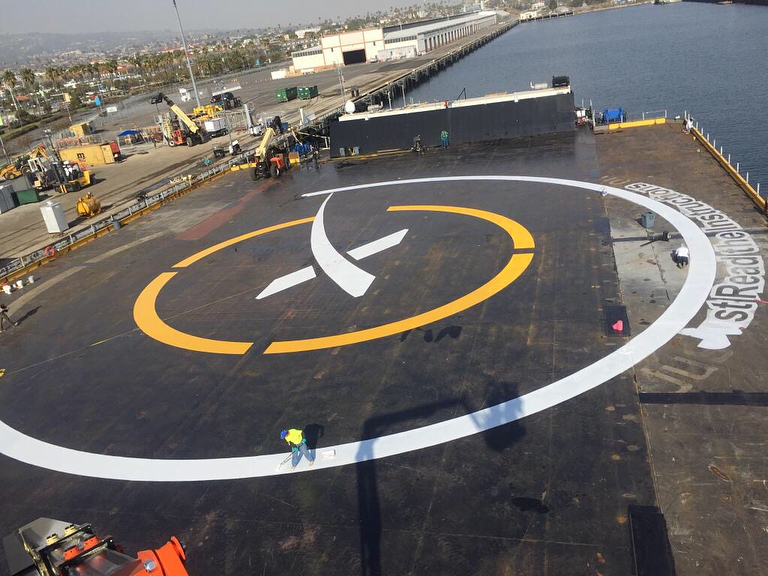
SpaceX’s West coast drone ship Just Read The Instructions getting some much needed fresh paint in 2017. (Instagram, anonymous)
Three months after that October mission and booster recovery, SpaceX expended their next California launch and marked the beginning of a streak of eight missions where flight-proven Block 3 and 4 boosters could have been recovered but no attempts were made. While intermixed with the spectacle of Falcon Heavy’s dual side booster landings at LZ-1, the debut launch and recovery of Falcon 9 Block 5, and two other Block 4 booster recoveries, the majority of SpaceX’s launches since December 2017 have been treated as expendable – put simply, the company decided that recovering and refurbishing twice-flown boosters of older Falcon 9 blocks was not worth the effort and expense.
Instead, those well-worn boosters were expended in the Pacific and Atlantic Oceans after partially supporting a series of experimental tests designed to gather additional data on the recovery envelope of SpaceX’s partially reusable rockets. The rationale makes sense – SpaceX fundamentally sacrificed some of its older, less-reusable Falcon 9 boosters for the sake of knowledge that may allow their highly reusable Falcon 9 Block 5 predecessors a better chance of successfully landing even after exceptionally fast, hot, and high-energy recoveries, a necessity if the upgraded rockets are to be reused 10 to 100 times, as is the goal.
Although Just Read The Instructions spent several months without a full complement of maneuvering thrusters, thanks in part to efforts to keep its besieged East coast sister Of Course I Still Love You operational, photographer Pauline Acalin’s photos over the last several months show that the vessel now has four full thrusters installed and ready to bring it back into rocket recovery action in the Pacific Ocean.
- SpaceX’s drone ship Just Read The Instructions and fairing catcher Mr Steven at their Port of San Pedro berths, May 2018. Note the four bright blue thrusters visible aboard JRTI, three installed and one on deck. (Pauline Acalin)
- The aggressive Atlantic Ocean landing of Thaicom-8’s Falcon 9 first stage. (SpaceX)
- Iridium-1’s successful and scenic landing on Pacific drone ship JRTI, January 2017. This could be an increasingly rare occurrence in the Pacific, thanks to SpaceX’s new land-based landing zone. (SpaceX)
Still, the abrupt return to expendable rocket launches after a year – 2017 – filled to the brim with 18 of 18 successful launches and 14 of 14 successful landings led to a decidedly fascinating vein of disapproval in the SpaceX enthusiast and broader spaceflight fan communities – people had grown accustomed to the adrenaline-soaked thrill of routine Falcon 9 rocket landings. Some expressed worries that regularly and intentionally expending large hunks of metal in the ocean could harm their ecosystems and was tantamount to littering. None the wiser, every other launch provider in the world continues to expend all of their rocket boosters without any attempts at recovery like the nearly all non-Shuttle rocket launches in the past six decades, and their tepidly reusable next-generation rockets are unlikely to even begin attempting hardware recovery until the mid-2020s at the earliest.
Frankly, SpaceX’s abrupt successes with orbital-class rocket recovery struck a chord with observers, demonstrating just how intuitive attempting to recover expensive rocket hardware really is, while also bringing into clear focus the actual insanity of failing to try and of the seemingly ad-hoc rationalization of expendable rocketry. Thankfully, we still have SpaceX, and the company’s spate of rocket booster sacrifices is likely just one expendable launch away from coming to an effective end for the indefinite future, with that particular launch – CRS-15 – scheduled less than two weeks from now, on June 29th.
- B1045, tasked with launching NASA’s TESS exoplanet observatory, roughly 24 hours before liftoff. (Tom Cross)
- After launching in April 2018, B1045 landed on OCISLY and is being refurbished for a second launch in just 5 days, on June 29. (Tom Cross)
After CRS-15, which will probably see its twice-flown Block 4 booster expended in the Atlantic, a combination of Block 5 Falcon 9s and Heavies will theoretically bring to an end the practice of expending orbital rocket boosters, at least on SpaceX’s watch. Considering that the upgraded boosters have been designed and built to launch as many as ten times with minimal refurbishment and potentially 100+ times with regular maintenance, the opportunity cost of an expended Block 5 rocket booster is so high that it is difficult to imagine SpaceX will be easily swayed to expend one until it’s flown at least several times prior.
We here at Teslarati eagerly await the imminent demise of expendable rockets, set to begin in earnest – at least for SpaceX – around July 19th and 20th with two Falcon 9 Block 5 launches on two coasts, one with Telstar 19V (Florida) and the other with Iridium-7 (California).
Follow us for live updates, peeks behind the scenes, and photos from Teslarati’s East and West coast photographers.
Teslarati – Instagram – Twitter
Tom Cross – Twitter
Pauline Acalin – Twitter
Eric Ralph – Twitter

Cybertruck
Tesla updates Cybertruck owners about key Powershare feature

Tesla is updating Cybertruck owners on its timeline of a massive feature that has yet to ship: Powershare with Powerwall.
Powershare is a bidirectional charging feature exclusive to Cybertruck, which allows the vehicle’s battery to act as a portable power source for homes, appliances, tools, other EVs, and more. It was announced in late 2023 as part of Tesla’s push into vehicle-to-everything energy sharing, and acting as a giant portable charger is the main advantage, as it can provide backup power during outages.
Cybertruck’s Powershare system supports both vehicle-to-load (V2L) and vehicle-to-home (V2H), making it flexible and well-rounded for a variety of applications.
However, even though the feature was promised with Cybertruck, it has yet to be shipped to vehicles. Tesla communicated with owners through email recently regarding Powershare with Powerwall, which essentially has the pickup act as an extended battery.
Powerwall discharge would be prioritized before tapping into the truck’s larger pack.
However, Tesla is still working on getting the feature out to owners, an email said:
“We’re writing to let you know that the Powershare with Powerwall feature is still in development and is now scheduled for release in mid-2026.
This new release date gives us additional time to design and test this feature, ensuring its ability to communicate and optimize energy sharing between your vehicle and many configurations and generations of Powerwall. We are also using this time to develop additional Powershare features that will help us continue to accelerate the world’s transition to sustainable energy.”
Owners have expressed some real disappointment in Tesla’s continuous delays in releasing the feature, as it was expected to be released by late 2024, but now has been pushed back several times to mid-2026, according to the email.
Foundation Series Cybertruck buyers paid extra, expecting the feature to be rolled out with their vehicle upon pickup.
Cybertruck’s Lead Engineer, Wes Morrill, even commented on the holdup:
As a Cybertruck owner who also has Powerwall, I empathize with the disappointed comments.
To their credit, the team has delivered powershare functionality to Cybertruck customers who otherwise have no backup with development of the powershare gateway. As well as those with solar…
— Wes (@wmorrill3) December 12, 2025
He said that “it turned out to be much harder than anticipated to make powershare work seamlessly with existing Powerwalls through existing wall connectors. Two grid-forming devices need to negotiate who will form and who will follow, depending on the state of charge of each, and they need to do this without a network and through multiple generations of hardware, and test and validate this process through rigorous certifications to ensure grid safety.”
It’s nice to see the transparency, but it is justified for some Cybertruck owners to feel like they’ve been bait-and-switched.
News
Tesla’s northernmost Supercharger in North America opens

Tesla has opened its northernmost Supercharger in Fairbanks, Alaska, with eight V4 stalls located in one of the most frigid cities in the U.S.
Located just 196 miles from the Arctic Circle, Fairbanks’s average temperature for the week was around -12 degrees Fahrenheit. However, there are plenty of Tesla owners in Alaska who have been waiting for more charging options out in public.
There are only 36 total Supercharger stalls in Alaska, despite being the largest state in the U.S.
Eight Superchargers were added to Fairbanks, which will eventually be a 48-stall station. Tesla announced its activation today:
North America’s northernmost Supercharger Fairbanks, AK (8 stalls) opened to public. https://t.co/M4l04DZ6B5 pic.twitter.com/zyL6bDuA93
— Tesla Charging (@TeslaCharging) December 12, 2025
The base price per kWh is $0.43 at the Fairbanks Supercharger. Thanks to its V4 capabilities, it can charge at speeds up to 325 kW.
Despite being the northernmost Supercharger in North America, it is not even in the Top 5 northernmost Superchargers globally, because Alaska is south of Norway. The northernmost Supercharger is in Honningsvåg, Norway. All of the Top 5 are in the Scandanavian country.
Tesla’s Supercharger expansion in 2025 has been impressive, and although it experienced some early-quarter slowdowns due to V3-to-V4 hardware transitions, it has been the company’s strongest year for deployments.
🚨🚨 Tesla Supercharging had a HUGE year, and they deserve to be recognized.
🍔 Opened Tesla Diner, a drive-in movie theater with awesome, Chef-curated cuisine
🔌 Gave access to Superchargers to several EV makers, including Hyundai, Genesis, Mercedes-Benz, Kia, Lucid, Toyota,… pic.twitter.com/yYT2QEbqoW
— TESLARATI (@Teslarati) December 10, 2025
Through the three quarters of 2025, the company has added 7,753 stations and 73,817 stalls across the world, a 16 percent increase in stations and an 18 percent increase in stalls compared to last year.
Tesla is on track to add over 12,000 stalls for the full year, achieving an average of one new stall every hour, an impressive statistic.
Recently, the company wrapped up construction at its Supercharger Oasis in Lost Hills, California, a 168-stall Supercharger that Tesla Solar Panels completely power. It is the largest Supercharger in the world.
News
Tesla shocks with latest Robotaxi testing move
Why Tesla has chosen to use a couple of Model S units must have a reason; the company is calculated in its engineering and data collection efforts, so this is definitely more than “we just felt like giving our drivers a change of scenery.”

Tesla Model S vehicles were spotted performing validation testing with LiDAR rigs in California today, a pretty big switch-up compared to what we are used to seeing on the roads.
Tesla utilizes the Model Y crossover for its Robotaxi fleet. It is adequately sized, the most popular vehicle in its lineup, and is suitable for a wide variety of applications. It provides enough luxury for a single rider, but enough room for several passengers, if needed.
However, the testing has seemingly expanded to one of Tesla’s premium flagship offerings, as the Model S was spotted with the validation equipment that is seen entirely with Model Y vehicles. We have written several articles on Robotaxi testing mules being spotted across the United States, but this is a first:
🚨 Tesla is using Model S vehicles fitted with LiDAR rigs to validate FSD and Robotaxi, differing from the Model Ys that it uses typically
Those Model Y vehicles have been on the East Coast for some time. These Model S cars were spotted in California https://t.co/CN9Bw5Wma8 pic.twitter.com/UE55hx5mdd
— TESLARATI (@Teslarati) December 11, 2025
Why Tesla has chosen to use a couple of Model S units must have a reason; the company is calculated in its engineering and data collection efforts, so this is definitely more than “we just felt like giving our drivers a change of scenery.”
It seems to hint that Tesla could add a premium, more luxury offering to its Robotaxi platform eventually. Think about it: Uber has Uber Black, Lyft has Lyft Black. These vehicles and services are associated with a more premium cost as they combine luxury models with more catered transportation options.
Tesla could be testing the waters here, and it could be thinking of adding the Model S to its fleet of ride-hailing vehicles.
Reluctant to remove the Model S from its production plans completely despite its low volume contributions to the overall mission of transitioning the world to sustainable energy, the flagship sedan has always meant something. CEO Elon Musk referred to it, along with its sibling Model X, as continuing on production lines due to “sentimental reasons.”
However, its purpose might have been expanded to justify keeping it around, and why not? It is a cozy, premium offering, and it would be great for those who want a little more luxury and are willing to pay a few extra dollars.
Of course, none of this is even close to confirmed. However, it is reasonable to speculate that the Model S could be a potential addition to the Robotaxi fleet. It’s capable of all the same things the Model Y is, but with more luxuriousness, and it could be the perfect addition to the futuristic fleet.
